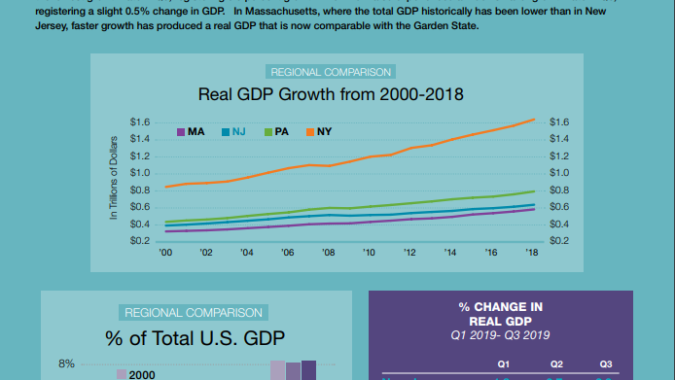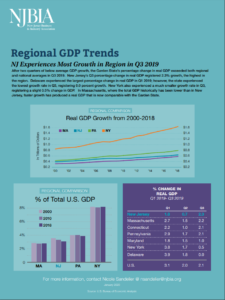New Jersey’s real GDP growth made a major turnaround in the third quarter of 2019, expanding 2.3% from Q2, according to data released this morning by the U.S. Bureau of Economic Analysis (BEA).
According to NJBIA Director of Economic Policy Research Nicole Sandelier, New Jersey’s growth rate led the region in Q3 after falling behind the area’s seven states over the first half of 2019. However, New Jersey’s average growth of 1.6% in the first three quarters of 2019 is less than the national average of 2.4% for the first three quarters of 2019.
New Jersey’s 2.3% growth in real GDP beat the national average of 2.1% and was tied with several other states for the 15th highest growth rate in the nation.
“This is good news for the state’s economy,” Sandelier said. “After two quarters of lackluster growth, this jump in economic output will help put New Jersey back in the middle of the pack for the year.”
Fourth quarter GDP growth statistics are scheduled to be released on April 7.
“The numbers indicate New Jersey businesses are still able to innovate and overcome the challenges of operating in a high-cost state,” Sandelier said.
Looking at the region, Delaware experienced the largest percentage change in real GDP in Q1 2019, but experienced no growth in Q3. New York’s GDP also contracted, registering 0.5% growth in Q3, down from 3.8 % growth in Q1. Massachusetts, where the total GDP historically has been lower than in New Jersey, produced 2.2% growth in real GDP. The Bay State now has a total GDP that is comparable with the Garden State’s.
“Robust economic growth can help New Jersey’s finances in the short term, which is important when you consider that New Jersey’s state expenses and debt are outpacing revenues,” Sandelier said.
According to the BEA, real GDP increased in 49 states and the District of Columbia in the third quarter of 2019. The percentage change in real GDP in the third quarter ranged from 4.0% in Texas to 0% in Delaware.
Nondurable goods manufacturing; retail trade; and professional, scientific, and technical services were the leading contributors to the increase in real GDP nationally.
- Nondurable goods manufacturing increased 10.1% for the nation and contributed to growth in all 50 states. This industry was the leading contributor to growth in Texas, the fastest growing state.
- Retail trade increased 8.2% for the nation and contributed to growth in all 50 states and the District of Columbia.
- Professional, scientific, and technical services increased 5.6% for the nation and contributed to growth in all 50 states and the District of Columbia.
In contrast, finance and insurance decreased 5.3% for the nation, subtracting from growth in all 50 states and the District of Columbia. This industry was the leading contributor to slow growth in New York and in Delaware – the slowest growing state.


